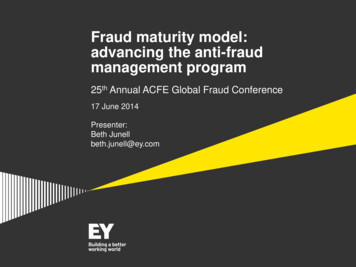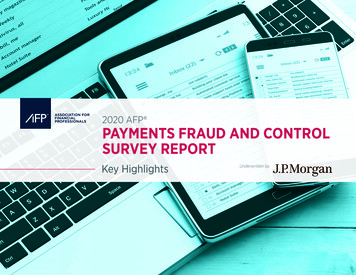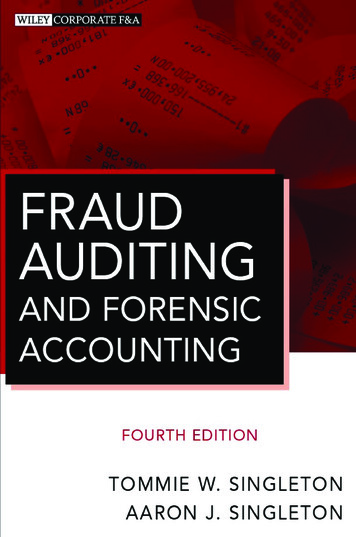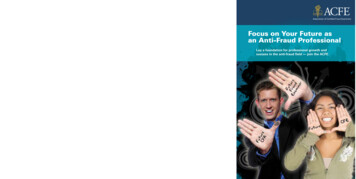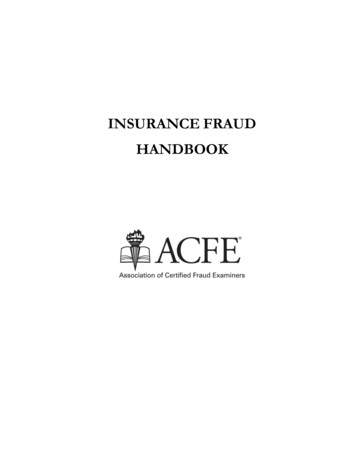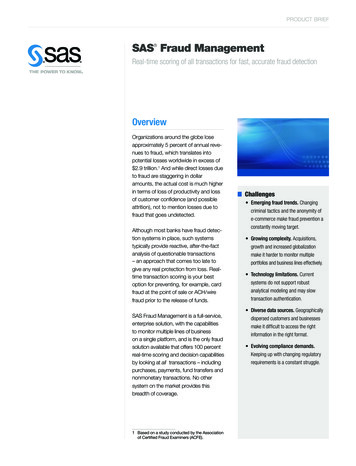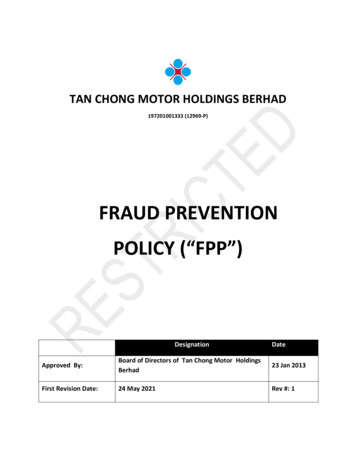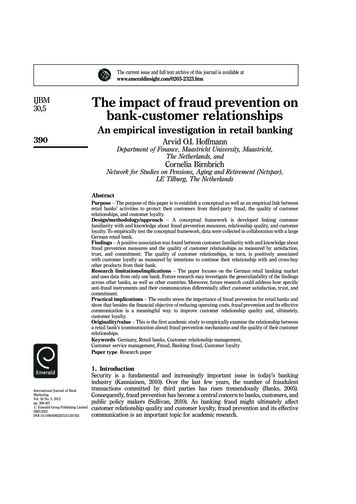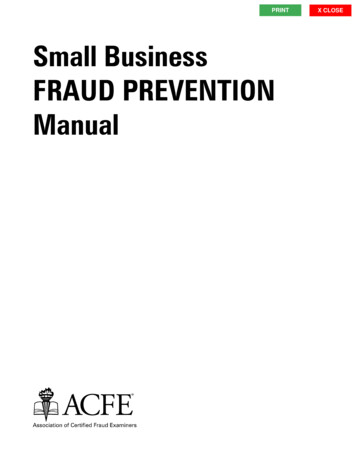
Transcription
PRINTSmall BusinessFraud PreventionManualX CLOSE
Introduction to Employee FraudPART 1: INTERNAL FRAUD THREATSI. INTRODUCTION TO EMPLOYEE FRAUDThe Shocking Cost of Employee Theft and FraudOccupational fraud is defined as the use of one‘s occupation for personal enrichment through thedeliberate misuse or misapplication of the organization‘s resources or assets.Simply stated, occupational fraud and abuse occurs when an employee, manager, or executive commitsfraud against his or her employer. Occupational fraud and abuse is roughly a synonym for terms likeemployee fraud or embezzlement, although technically, the term occupational fraud and abuse is more broad andbetter reflects the full range of employee misconduct through which organizations lose money.The threat of occupational fraud looms over every business or public agency, regardless of its size,stature, or function. It is safe to say that if you have employees, at some point in time some form ofoccupational fraud will victimize you. These are not crimes that only happen to the company down thestreet; they occur in every organization (including yours) and employees at every level commit them —from top executives down to entry-level clerks. Research indicates that levels of occupational fraud andabuse are staggeringly high, both in their cost and in their rate of occurrence.In 2003, KPMG released the results of its third U.S. Fraud Survey. The survey drew on interviews ofmore than 450 executives in medium-sized and large organizations across industries and in state andfederal government agencies. According to the results of KPMG‘s 2003 Fraud Survey, organizations arereporting more experiences of fraud than in prior years and are taking concerted actions to deal with it.Seventy-five percent of companies surveyed reported that they experienced an instance of fraud — 13percentage points more than in their 1998 survey.Their survey showed that while employee fraud is the most prevalent type of fraud experienced byorganizations, financial reporting fraud and medical/insurance fraud are the most costly. Their surveyalso showed that collectively, organizations are working hard to combat fraud. Three out of 4organizations evaluated their compliance programs within the last 12 months. An equally large numberplans to implement new programs or procedures to help combat fraud and misconduct in directresponse to the Sarbanes-Oxley Act.In March 2007, KPMG released its 2005-2006 Integrity Survey. The results of the survey were based onresponses from 4,056 U.S. employees, spanning all levels of job responsibility, 16 job functions, 11Small Business Fraud-1-
Introduction to Employee Fraudindustry sectors, and 4 thresholds of organizational size. According to the results of the survey, nearlythree out of four employees reported that they have observed misconduct in the workplace in the prior12-month period, with half of employees reporting that what they have observed was seriousmisconduct that could cause ―a significant loss of public trust if discovered.‖ Between 2000 (when thefirst Integrity Survey was conducted) and 2005, employees reported consistent levels of overallmisconduct, with 74% reporting in 2005 that they had observed misconduct — compared with 76% in2000, and consistent levels of serious misconduct — with 50% in 2005 characterizing the misconductthey observed as serious, compared with 49% in 2000. Although the level of observed misconduct hasremained constant, employees reported that the conditions that facilitate management‘s ability toprevent, detect, and respond to fraud and misconduct within companies are improving. Employees whoworked in companies with comprehensive ethics and compliance programs reported more favorableresults across the board than did those who worked in companies without such programs. For instance,employees who worked in companies with such programs reported fewer observations of misconductand higher levels of confidence in management‘s commitment to integrity.In 2006, Ernst & Young conducted its ninth biennial global survey on fraud risk in emerging markets.They found that one in five respondents — regardless of region, industry, or size of business — saidthey had experienced a significant fraud in the past two years. E&Y found that robust internal controlsremained the first line of defense against fraud for companies in all markets, but anti-fraud controls arenot always integrated under an anti-fraud program or separately monitored for operating effectiveness.Over 90% of respondents believe that their internal controls are sufficient to identify and investigatefraud promptly. A heightened sensitivity to the effectiveness of internal controls is evidenced by therespondents‘ views on the reasons for investigating fraud. In the 2003 global fraud survey, investigatingfraud was primarily driven by a desire to determine the extent of the fraud and to bring an end to it. Inthe 2006 survey, over 50% of respondents now investigate fraud with a clear desire to identify andimprove internal control weaknesses, hence, preventing future frauds.According to the E&Y survey, on a global basis, over 40% of companies do not have a formal antifraud policy. This demonstrates that the implementation of corporate governance guidelines and thefocus on internal controls has not automatically extended to the adoption of a formal anti-fraud policy.Less than half of the companies with anti-fraud policies communicate those policies to their suppliersand customers, while even fewer communicate them to agents/intermediaries and joint venturepartners. Of the companies surveyed, alarmingly 72% do not provide their employees with training tounderstand and implement the organization‘s anti-fraud policy.In September 2007, the 2006 National Retail Security Survey was released which reported that retailersattributed 47% of their company‘s losses to employee theft in 2006. Assuming a total inventoryshrinkage dollar amount of approximately 40.5 billion, this translates into an annual employee theft-2-Small Business Fraud
Introduction to Employee Fraudprice tag of 19 billion. This is a staggering monetary loss to come from a single crime type. In fact,there is no other form of larceny that annually costs American citizens more money than employeetheft.In 2008, the Association of Certified Fraud Examiners published the fifth Report to the Nation onOccupational Fraud and Abuse, which was based on a survey of 959 Certified Fraud Examiners throughoutthe United States. Those CFEs estimated that, within their own companies, losses due to fraud andabuse accounted for approximately 7% of annual revenues. If this figure is applied to the U.S. GrossDomestic Product — which is estimated to be 14,196 trillion in 2008 — this translates to losses ofabout 994 billion annually. This finding differs from the first, second, third and fourth Report to theNation, conducted in 1996, 2002, 2004 and 2006 respectively, in which CFEs estimated that theirorganizations lost 5-6% of revenues to fraud.Unfortunately, any estimate of the total cost fraud imposes on our economy is just thatan estimate.The 7% figure reflected by the Report to the Nation is simply the collective opinions of those who work inthe anti-fraud field. The figure provides a best-guess point of reference based on the opinions of 959anti-fraud experts with a median of 15 years‘ experience in the prevention and detection of occupationalfraud. Finding the actual cost may not be possible by any method. Many organizations are reluctant toreport fraud when it occurs for fear that it will make them look vulnerable to consumers or hurt theirstock price. Some feel embarrassment at having been victimized and prefer closure to the ongoingprocess of discovery that comes with an investigation and prosecution. Even those who do report fraudcases frequently are unable to determine the true cost sustained by the crime. And, of course, there arethe frauds that are not caught, that go on day after day, silently draining organizational resources. Allthese factors make it virtually impossible to determine how big a factor fraud is in the business world.But whatever the actual costs, it is clear that they are high, and organizations are unwittingly paying themalready as a part of their total operating expenses.The Cost of Fraud to Small BusinessesThe 2008 Report to the Nation was designed in part to help measure the effects fraud has on businesses ofvarious sizes. The fraud schemes that we studied were classified according to size of the victimcompanies (based on number of employees). We then sought to determine the median cost ofoccupational fraud schemes based on the size of the organization that is victimized. Continuing thetrend we have seen in our previous studies, small businesses — defined as those with less than 100employees — suffered both a greater percentage of frauds (38%) and a higher median loss ( 200,00)than their larger counterparts. These findings accentuate the unique problems in combating fraud —primarily the limited amount of fiscal and human resources available for anti-fraud efforts — frequentlyfaced by small organizations.Small Business Fraud-3-
Introduction to Employee FraudSize of Victim Organization — Frequency38.2%36.0%Number of Employees 8.9%18.9%10,000 0%10%20%30%40%50%Percent of CasesSize of Victim Organization — Median Loss 200,000 190,000 100 176,000 179,000100-999 116,000 120,0001,000-9,99920082006 147,000 150,00010,000 0 50,000 100,000 150,000 200,000 250,000Median LossThere appear to be two key factors that contribute to the large losses suffered by small companies. First,organizations with small staffs often lack basic accounting controls. Many small businesses have a oneperson accounting department — a single employee writes checks, reconciles the accounts, and poststhe books. Whenever control of a company‘s finances is consolidated in a single individual, occupationalfraud is easy to commit and conceal.-4-Small Business Fraud
Introduction to Employee FraudThe second reason losses are so high in small organizations is that there tends to be a greater degree oftrust among co-workers in small businesses. In an atmosphere where employees and management knoweach other well on a personal basis they tend to be less alert to the possibility of fraud.Methods of Fraud in Small BusinessesBecause of persistent evidence suggesting that fraud operates on small businesses differently than onlarger organizations, the ACFE felt it was important to identify the most common schemes in smallorganizations. This may provide some guidance to small business owners on where to focus anti-fraudefforts. To better understand the fraud issues faced by small businesses, the ACFE measured thefrequency with which different fraud schemes occurred in these organizations. As the chart belowillustrates, check tampering was much more common in small businesses than in other organizations.Over one-fourth of all small business frauds involved this form of fraud, which commonly occurs insituations where duties over the cash disbursement function are not segregated. Anecdotal evidencesuggests this control weakness is often present in small organizations. Billing schemes, skimming, cashlarceny, and payroll fraud were also noticeably more common in small businesses.SMALL BUSINESS — 100 EMPLOYEES(342 CASES)SchemeCasesBilling98Check Tampering87Corruption81Skimming71Expense Reimbursement53Cash on Hand53Larceny52Non-Cash51Payroll48Fraudulent Financial Statements42Register Disbursements12Small Business .0%12.3%3.5%-5-
Introduction to Employee FraudMethods of Fraud—Small Business Cases vs. All 28.7%20.8%14.9%16.3%Non-CashCheck Tampering25.4%14.7%15.5%13.2%Expense ReimbursementCash On Hand12.6%Small Bus.15.5%All Cases12.3%10.3%Fraudulent StatementsCash Larceny10.3%Payroll9.3%15.2%14.0%3.5%2.8%Register Disbursements0%10%20%30%40%Percent of CasesDetecting Fraud in Small BusinessesSmall businesses are typically thought to have fewer or weaker controls in place than their largercounterparts, primarily due to a lack of personnel or financial resources. The results of our survey bearthis out, as a lower percentage of frauds in small businesses were caught by internal controls.Additionally, internal audits and tips were cited as the detection method in fewer small business casesthan among all cases, while small business frauds were also more likely to be detected by accident. Thesefindings indicate that small organizations have room for improvement in their proactive fraud detectionefforts.Initial Detection of Frauds in Small Businesses41.7%46.2%TipBy AccidentInternal AuditInternal ControlsExternal AuditNotified by .2%Small BusinessesAll Cases0% 10% 20% 30% 40% 50%Percent of Cases-6-Small Business Fraud
Introduction to Employee FraudWhy Employees Commit FraudDonald R. Cressey and the Fraud TriangleWhen asked why employees commit fraud, most people would say it is because the perpetrators are―greedy‖ or ―con artists‖ or something of the like. These terms imply that the offenders possess somedefect of character that separates them from normal, law-abiding citizens. By using these terms; we areable to view occupational fraud as an aberration, something far outside the norm, and as misdeedscommitted by ―bad‖ people. To extend the implication, as long as we employ ―good‖ people, we wouldbe safe from falling victim to an occupational fraud scheme.The truth, however, is that even ―good‖ people commit occupational fraud. To be sure, fraudconstitutes aberrational conduct and it necessarily involves both greed and deception. Furthermore,there are some predatory employees who move from job to job with the sole intent of robbing whoeveris unlucky enough to hire them. But most fraudsters are not career criminals. Most employees whoembezzle do not take their jobs with the intention of stealing from their company. Typically, theemployee who steals from his or her company is an otherwise law-abiding citizen who, for a variety ofreasons, crosses the line into illegal conduct. In fact, when fraud occurs in a small business, it is usuallycommitted by a long-term, trusted employee. If your company is victimized by employee fraud, the newemployee who keeps to himself, the one who seems a little shady, probably won‘t commit it. Chancesare the one who steals from you will be the highly trusted employee, the hardest-working person in yourcompany, the one who‘s been with you ten years and knows your children‘s‘ names. After smallbusinesses have been attacked by an employee fraud scheme, the most commonly repeated sentiment is,―I never would have thought it would be him/her.‖ The biggest hurdle for most people to get over interms of understanding occupational fraud is to realize that anyone can commit fraud.Once we understand that fraud can be committed by anyone, the obvious question is, why do they doit? What causes certain employees to commit fraud? When trying to understand what motivates thisform of criminal behavior, we must first understand that there is no single factor that causes employeesto commit fraud. Instead, there is a complex set of motivators that, when combined in the rightenvironment, produce the impetus for an employee to begin committing fraud.The most widely accepted theory for explaining why people embezzle was postulated by Dr. Donald R.Cressey (1919-1987). Cressey was intrigued by embezzlers, whom he called ―trust violators.‖ In 1953,while working on his doctorate at Indiana University, Cressey decided to focus his dissertation on thefactors that lead people to embezzle. He was especially interested in the circumstances that led otherwisehonest people to be overcome by temptation. For that reason, he excluded from his research thoseemployees who took their jobs for the purpose of stealing — a relatively minor number of offenders atthat time.Small Business Fraud-7-
Introduction to Employee FraudTo serve as a basis for his work, Cressey conducted extensive interviews with about 200 inmates atMidwest prisons who had been incarcerated for embezzlement. Upon completion of his interviews, hedeveloped what still remains the classic model for the occupational offender. His research was publishedin Other People‘s Money: A Study in the Social Psychology of Embezzlement.Cressey‘s final hypothesis was:Trusted persons become trust violators when they conceive of themselves as having a financial problemwhich is nonsharable, are aware this problem can be secretly resolved by violation of the position offinancial trust, and are able to apply to their own conduct in that situation verbalizations which enablethem to adjust their conceptions of themselves as trusted persons with their conceptions of themselves asusers of the entrusted funds or property.Over the years, the hypothesis has become better known as the Fraud Triangle. According to the FraudTriangle Theory, there are three factors (each represented by a leg of the triangle) that when combined,lead people to commit occupational fraud. One leg represents a perceived nonsharable financial need. Thesecond leg represents a perceived opportunity to secretly resolve the financial need. The third leg representsthe perpetrator‘s ability to rationalize the illegal conduct, to justify crime in their mind. One of the mostfundamental observations of the Cressey study was that it took all three elements — perceived motive,perceived opportunity, and the ability to rationalize — for the trust violation (fraud) to RATIONALIZATIONSmall Business Fraud
Introduction to Employee FraudNonsharable Financial NeedThe role of the nonsharable financial problem is crucial. An otherwise honest employee usually onlystarts committing fraud when faced with some great financial pressure. The extreme need for moneyleads the person to engage in illegal acts, something the person probably would not do under normalcircumstances. In his study, Cressey asked his subjects why they had embezzled in one instance, but hadrefrained from doing the same thing in previous jobs or positions of trust when they had had thechance. Their responses usually fell into one of the following categories: ―(a) ‗There was no need for itlike there was this time.‘ (b) ‗The idea never entered my head.‘ (c) ‗I thought it was dishonest then, butthis time it did not seem dishonest at first.‘‖Keep in mind that the first leg of the triangle is not simply financial pressure. We all have financialpressure. The common element in the subjects Cressey studied was a perceived, nonsharable financialpressure. Cressey wrote, ―In all cases of trust violation encountered, the violator considered that a financial problemwhich confronted him could not be shared with persons who, from a more objective point of view, probably could have aidedin the solution of the problem.‖ In general, nonsharable financial problems are those that carry, in thesubject‘s mind, some sort of shame or stigma. As a result, the subject feels unable to discuss theproblem or seek help from others.That which is considered ―nonsharable‖ is wholly in the eyes of the potential occupational offender,Cressey said. One person might lose 1,000 gambling at the racetrack, but not consider this to be anonsharable problem. Another man who loses the same 1,000 might feel a sense of shame attached tothe loss and therefore feel the need to keep his loss secret. Although both men have experienced thesame loss in terms of dollars, only the second man has experienced a perceived nonsharable financialproblem. It is the second man who is more likely to resort to secret, illegal means to rectify his problem.Cressey divided ―nonsharable‖ problems into six basic subtypes:Violation of ascribed obligations: the subject faces the prospect of being unable to pay his debts.Problems resulting from personal failure: the subject experiences problems such as drugaddiction that result from poor personal judgment.Business reversals: the subject faces the prospect of a failing business.Physical isolation: the subject is isolated from people who could help him with his problem.Status gaining: the subject seeks to maintain a certain status level but does not have the financialmeans to do so.Employer-employee relations: the subject feels he has been mistreated by his employer and needsto ―get even.‖Small Business Fraud-9-
Introduction to Employee FraudPerceived OpportunityHaving a perceived nonsharable financial need is only one element of the fraud tree. In order for theemployee to take the next step towards committing fraud that employee must believe he will be able toresolve his financial situation in secret. In other words, he must perceive that there is an opportunity to fixthe problem without being caught. Cressey wrote:―Although the clear conception of a financial problem as nonsharable does not invariably result in trustviolation, it does establish in trusted persons a desire for a specific kind of solution to their problems. Theresults desired in the cases encountered were uniform: the solution or partial solution of the problem by theuse of funds which can be obtained in an independent, relatively secret, safe, and sure method in keepingwith the ‗rationalizations‘ available to the person at the time.‖The perceived opportunity leg of the fraud triangle is very important because it goes right to the heart ofwhat companies do to prevent fraud. Generally, employee‘s only commit fraud when they perceive thatthere is a way to commit the crime in such a way that the company will not realize a fraud has occurred.After all, if the fraud is discovered, the employee will face punishment, humiliation, and loss of job.Unlike the typical street criminal, the employee who commits fraud is not in a position to steal moneyand flee the scene. On the contrary, the employee-fraudster has to keep coming back to the scene of thecrime every day.If an employee knows, for instance, that he is the only person who writes checks, posts entries, andreconciles the checking account, then he may perceive that there is an opportunity to solve his financialproblem by writing a check to himself, a creditor, etc. If no one ever looks at the checkbook, the fraudwill never be discovered. The employee will see an opportunity to solve his personal crisis withoutgetting caught. On the other hand, if the employee knows that someone always reviews the monthlybank statement or that authorized check signers will question any suspicious checks, then he willperceive that if he tries to write a fraudulent check, the crime will be detected.This illustrates the key to preventing fraud: perception of detection. Employees are less likely to commitfraud when they believe that the company will detect it. Therefore, by establishing strong controls andby letting employees know that management is looking out for fraud, a company can deter its employeesfrom attempting to steal.RationalizationThe third leg of Cressey‘s fraud triangle deals with rationalization — how are offenders able to convincethemselves that stealing is okay? Cressey found they were able to excuse their actions to themselves by- 10 -Small Business Fraud
Introduction to Employee Fraudviewing their crimes as (1) noncriminal, (2) justified, or (3) part of a situation, which the offender doesnot control.Recall that most employees who commit fraud are not career criminals at least they don‘t start out thatway. These are generally people who consider themselves to be upright, law-abiding citizens. Therefore,in order for them to begin stealing, it is critical for them to be able to develop some excuse to rationalizetheir conduct and help them maintain their image of themselves as moral people. Also, by developing arationalization they feel that their conduct will be explainable if it is discovered. One of the simplestways to justify unacceptable conduct and avoid feelings of guilt is to invent a good reason forembezzling — one sanctioned in the social group as a greater good.There are several rationalizations that are common to embezzlers and are repeated over and over bythose who are caught committing occupational fraud. They include:―I was only borrowing. I was going to pay everything back.‖―I only did it because of unusual circumstances. Normally, I‘d never have taken the money.‖―I did it to provide for my family (pay bills, keep up the mortgage, etc.).‖―My employer had been cheating me/treating me unfairly. I only did it to get even.‖―My employer is dishonest. They rip off their customers; so they deserve to be ripped off.‖―I had to have the money. I only did it out of necessity.‖―Everybody does it.‖―After all I‘ve done for the company, I was entitled to it.‖ConclusionsCressey‘s classic fraud triangle helps explain the nature of many — but not al l— occupationaloffenders. It is obvious that one model will not fit all situations. In addition, Cressey‘s study is nearlyhalf a century old. There has been considerable social change in the interim. And now, many anti-fraudprofessionals believe there is a new breed of occupational offender — one who simply lacks aconscience sufficient to overcome temptation.Cressey‘s model also does not fit the predatory employee who takes a job with the intent of stealing. Butfor the majority of occupational fraudsters, the fraud triangle provides a framework to explain why theycommit their crimes. Companies can use Cressey‘s model to help them prevent employee fraud. Forinstance, because we know that most employees start stealing when faced with a nonsharable financialproblem, companies can be alert for employees who exhibit signs of stress or who indicate that they are ina bad financial situation. By establishing open door policies, companies can provide these employeeswith a place to air their problems, to seek help, and to hopefully find solutions before they turn to fraud.Small Business Fraud- 11 -
Introduction to Employee FraudWith regard to the second leg of the fraud triangle, companies can attempt to limit perceived opportunities tocommit fraud. This can be accomplished in a variety of ways: establish strong internal controls; separateduties; conduct random audits or cash counts (let employees know random tests will be conducted, butnot when); establish a management presence wherever cash or merchandise is handled; and terminateand refer for prosecution anyone who is caught committing fraud; etc.Regarding the third leg of the fraud triangle, companies can look for signs of rationalization amongemployees, particularly those who are already at-risk fraud candidates. Be aware of employees who seemdisgruntled, who feel they have been treated unfairly or passed over for promotions. Also look for signsof extreme financial stress that could lead an employee to justify misconduct. Finally, reviewcompensation policies to make sure employees receive adequate pay based on their jobs and the labormarket. Simply stated, happy employees are less likely to steal.Continuing ConductCressey‘s model is a great tool for explaining why employees begin to commit fraud, but experienceshows that once an employee starts stealing, they will tend to continue. The thefts usually get larger ormore frequent (or both) until the perpetrator gets caught or leaves the company, or until the company isdriven out of business. As fraud schemes progress, the importance of the elements that make up thefraud tree begin to diminish. For instance, suppose Anne, a bookkeeper, begins writing company checksto pay off a personal debt. Once Anne sees that she can write bad checks without getting caught, shewill become hooked on the source of extra income that she has found. Though the scheme may havebegun because of a nonsharable financial problem, she will tend to continue with it, even after theimmediate problem has been solved. She may start writing checks to pay for luxury items, vacations, andother non-essential purchases. Likewise, she might begin the scheme by rationalizing that she is onlyborrowing the money from the company. But as the scheme progresses, there will be less and less needfor her to keep rationalizing her misconduct. The theft will become the norm for her, to the point whereshe will not have to justify it to herself at all, until she finally gets caught.The preceding example illustrates what some anti-fraud professionals have dubbed ―The Potato ChipTheory of Fraud.‖ As the theory goes, a perpetrator cannot stop at just one fraud. They keep nibblingand nibbling. Frequently, these employees will continue their schemes even after they leave onecompany and start working for another. At this point, they have become what are known as predatoryemployees. These people fall outside the fraud triangle model; they steal not because of a defined set ofcircumstances, but as a matter of course. Small businesses can best protect themselves against thesepersons by conducting thorough background checks before hiring any employee, particularly anyonewho will have access to the company‘s cash or merchandise.- 12 -Small Business Fraud
Introduction to Employee FraudThe importance of screening out bad applicants or preventing existing employees from stealing cannotbe overstated. Many small businesses resist measures like internal controls because they are costly andtime consuming. But we must remember that the average fraud scheme in a small business costs 200,000, according to The Report to the Nation. Just because this cost doesn‘t show up on the balancesheet, does not mean it is not there. How much would you pay to save 200,000 in payroll or inventoryexpense? When we realize how much is to be lost by ignoring the threat of fraud, we see that measures
Seventy-five percent of companies surveyed reported that they experienced an instance of fraud — 13 percentage points more than in their 1998 survey. Their survey showed that while employee fraud is the most prevalent type of fraud experienced by organizations, financial reporting fraud and medical/insurance fraud are the most costly. Their .
